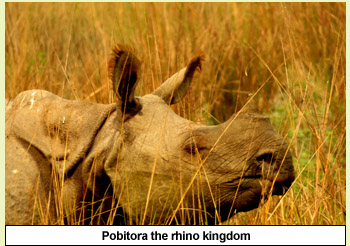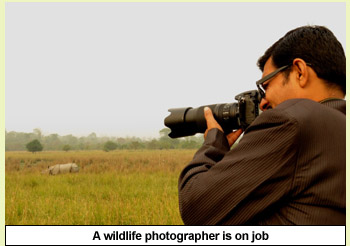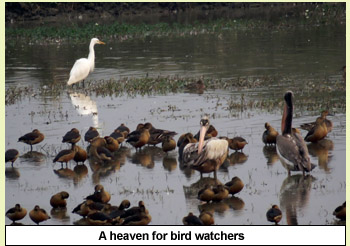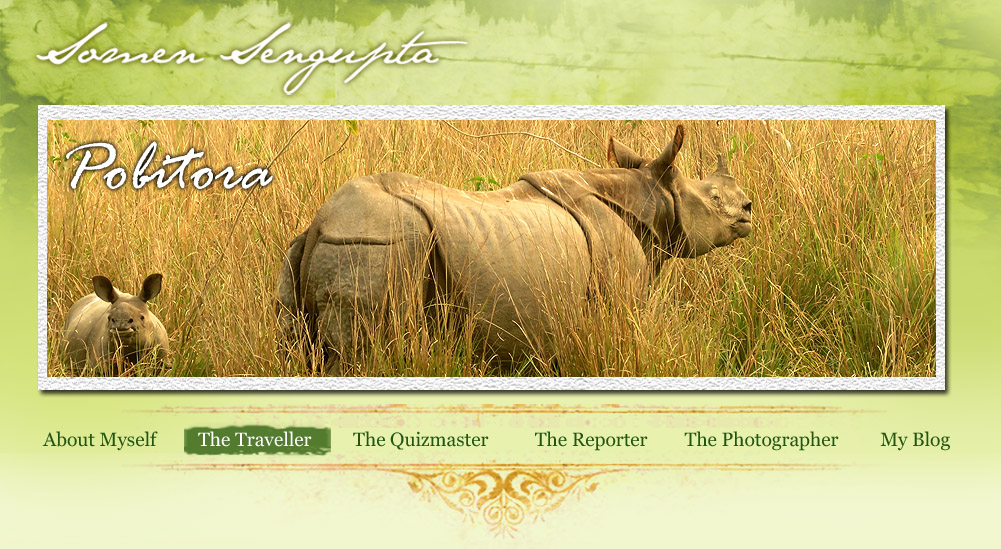| POBITORA WILDLIFE SANCTUARY : THE RHINO COUNTRY. |
|
 If the aroma of tea is the first identity of a charming land named
Assam then without any debate an animal can be placed as an icon of
Assam’s power & gigantic importance in our national framework. The
crowded streets of Guwahati and it’s nightmarish traffic system may
set you depressed but once you know the rich culture and wildlife of
Assam, obvious it is that you will change your view in a moment.
Surprise grabs once more when facts tell that physically one is almost
next to a reserve forest that has highest density of a creature which
is now very rare and unique. If the aroma of tea is the first identity of a charming land named
Assam then without any debate an animal can be placed as an icon of
Assam’s power & gigantic importance in our national framework. The
crowded streets of Guwahati and it’s nightmarish traffic system may
set you depressed but once you know the rich culture and wildlife of
Assam, obvious it is that you will change your view in a moment.
Surprise grabs once more when facts tell that physically one is almost
next to a reserve forest that has highest density of a creature which
is now very rare and unique.
This animal which was once found in abundance in many places of north
India now only found in various deep jungle of Assam & some of in
Bengal. While in Bengal their number is limited in Assam they are
pride of many reserve forest. Indian rhinoceros the unique unicorn
mammal with a huge structure symbolizes a powerhouse of a living
creature like elephant dons many forest of Assam & it is a matter of
delight that they are spotted almost effortlessly.
Assam has 2 national parks that don the title crown of UNESCO world
heritage sites. Kaziranga the world famous national park of Assam that
nests more than 2000 such beast & Manas National Park are often
visited by tourist but little known fact is that just 58 km from
Guwahati city there is another beautiful wildlife sanctuary that
houses good number of rhinos as well as many other interesting
wildlife. Sad that in attraction of Kaziranga & Manas many of us often
overlook this wildlife sanctuary that breathes almost on the neck of
Guwahati.
Pobitora is set in an unique picture post card setting.
Here the flood plain of mighty Bramhaputra is decorated with green
hills over the horizons. Named as Mairang or Moirang the magical hill
the place was once famous for necromancy and other black magic. Assam
is known for tantric cult for centuries and no place is better than
this wild jungle to practice such thing.
The vast green grass land down the hill is spread over Garanga beel a
huge water body near Bramhaputra river. From time immemorial when
human population was rare in this locality the place was a game arena
of many wild lives. However things started changing from 1960s when
human settlement started encroachment into the jungle. Considering the
increasing risk of man-animal conflict in 1961-62 an area of 38.81 sq
km was demarked as Pobitora jungle. On 18th November 1971 it was
announced as reserve forest and from 16th July 1987 it was officially
known as Pobitora Wildlife Sanctuary.
 As the car stops at the doorstep of the jungle the romance of dark
wood starts.A huge bill board displays details of the jungle and an
army of jeep awaits for passangers to take them inside of the
sanctuary.Thanks to the tourism department of Assam Govt till now not
too many hotels and restaurants are allowed to come up here. Instead
Assam Tourism office at the gate helps you to understand rule of the
jungle and also provides guides to see the wildlife in sound and safe
way.
As the car stops at the doorstep of the jungle the romance of dark
wood starts.A huge bill board displays details of the jungle and an
army of jeep awaits for passangers to take them inside of the
sanctuary.Thanks to the tourism department of Assam Govt till now not
too many hotels and restaurants are allowed to come up here. Instead
Assam Tourism office at the gate helps you to understand rule of the
jungle and also provides guides to see the wildlife in sound and safe
way.
One can take a safari of the jungle either on elephant back or in a
jeep.Tickets ofr both are issued from the same counter.
Elephant safari is conducted in early morning which is considered one
of the best time to spot wildlife. A group of 4 to 6 people ride on
each elephant’s back and thanks to good training every elephant goes
near to the spotted animal even if that is settled in water.
Safari in jeep has it’s own charm and needless to say much more
comfortable and safe compare to elephant ride that moves on the bumpy
roads in side of the forest.
Jeep safari starts from 1 pm and continues till late afternoon subject
to climate.
A group of 4-5 people plus an armed man from forest department goes in
every jeep. A 2 hour jeep safari runs on the meadows criss-crossing
the dark & deep woods.
It runs over the plain where behind the blade of big green grass the
pride of Assam suddenly makes a majestic emergence that can often
makes you feel a chill running down of your back bone.
In Pobitora rhinos are almost everywhere. Be it in mud or behind the
bush or behind the small blades of grasses they are watching you from
every corner with an exploded eyes and as it is their kingdom it will
be wise to behave like an obedient subject in front of them.
Jeep drivers are well trained to understand the mood of the animal.
They know how close to go or how loud to make the engine roar. The
huge beast generally watches more and moves less but in never accepts
any kind of disturbance to him. A big full grown bull is always
dangerous. Equally dangerous is a female rhino with her baby if she
feels unsafe in proximity of human.They are excellent in smelling but
with poor eye sight. One that makes rhino special is it’s thick skin
which is folded with cracks on it. Males grow their thick neck with a
lump of flesh under it. They have single horn unlike of their African
cousin. The horn prevails both in male and female but not in infant.
The horn is made of pure keratin one that makes human finger nail. As
rhino is solitary living animal they do not form large group in
common. Except mating time male and female hardly come close to each
other. However females are often seen with babies. So in Pobitora
rhinoceros is mostly alone but many in numbers.
Here rhinos are mostly of gray and fade black. Their massive structure
are almost 6 fi in height.Rhino that is found in Pobitora is typically
Indian rhino a wonder to the world.
In size Indian rhinos are the biggest in the world.
 An Indian rhino is weighted between 2260 kg to 4000 kg where male out
grows female. Mostly found in the alluvial grassland and river rine
this critically endangered creature in size is 2nd only to Asian
elephant. Surprising it may sound but the fact remains Indian rhinos
are bigger than African or Javan or Sumatran rhinos. In various old
mughal miniature painting rhino hunting by royals are featured and it
clearly indicates it’s existence and attraction in north India. The
majestic animal found reference in 16th century Baburnama where it’s
presence is mentioned from Hindukush mountain is west to Indo-Myanmar
border in east. Both Al Beruni and Ibn Batuta who travelled India in
Islamic age have given description of this animal in their respective
travelogues. However it was German painter Albrecht Duer ( 1471-1528)
who made many jaw fall in Europe when he for the first time published
a sketch of this unique animal which was never seen in that
continent.
An Indian rhino is weighted between 2260 kg to 4000 kg where male out
grows female. Mostly found in the alluvial grassland and river rine
this critically endangered creature in size is 2nd only to Asian
elephant. Surprising it may sound but the fact remains Indian rhinos
are bigger than African or Javan or Sumatran rhinos. In various old
mughal miniature painting rhino hunting by royals are featured and it
clearly indicates it’s existence and attraction in north India. The
majestic animal found reference in 16th century Baburnama where it’s
presence is mentioned from Hindukush mountain is west to Indo-Myanmar
border in east. Both Al Beruni and Ibn Batuta who travelled India in
Islamic age have given description of this animal in their respective
travelogues. However it was German painter Albrecht Duer ( 1471-1528)
who made many jaw fall in Europe when he for the first time published
a sketch of this unique animal which was never seen in that
continent.
Though rhino rules every grass of Pobitora they are not the only
attraction of the forest.
A pull of critically endangered and near threatened wild world very
peacefully co-exist here with 93 rhinos. Unbelievable fact is that 22
spices of mammals, 27 spices of reptiles,80 spices of butterflies, 9
spices of amphibians and 8 spices of turtles are often spotted here.
The most worth mentioning will be bear, leopard, lesser cat, wild
boar, Asiatic buffalo and barking dear.
For a bird lover it is a paradise. Thanks to the existence of vast
water body inside of the sanctuary massive number of migratory birds
are often found in Pobitora. More than 20000 birds of 214 specific
spices are found. Most surprising are cranes, Indian bastard, brown
ducks & pink pelicans. Presence of small yet attractive birds are
almost everywhere even on the back of a moving rhino which is
engrossed in grazing.
Thanks to forest department of Assam and local people today Pobitora
is an over populated sanctuary for rhinos. Many of them often coming
out of the forest and creating danger to villagers around. To prevent
this Assam Govt is now mobilizing few rhinos from here to other
forest.
Travel Logistics :
. Pobitora is just 36 km from Guwahati town and can be reached within 2 hours by car.
. Guwahati is well connected with all major Indian cities.
. Ample accommodation available both in Govt and private hotels.
. Useful website - www.assamtourism.gov.in & www.assamforest.in
. Jeep safari is subject to minimum number of people and tickets to be taken before.
. Extra money is charged for camera.
. Rhinos are dangerous if irritated – So please be very careful with them.
. Every jungle has it’s own rule – please co operate with wildlife force.
. No loud music inside the forest – keep your mobile silent.
. No photography with flash – no selfie atall.
. Elephant ride demands certain level of physical fitness.
The article was published in The Hitavada on 13th March 2016.
Click here to view the original article
|



